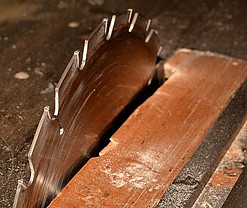Like anything else that is fun and exciting, getting injured in the process takes all the fun out of it.

Any hand tool used improperly can be very dangerous and power tools exponentially so. Sharp toothed blades spinning at high rpms are no respecter of persons. They will snip, cut and chew suddenly anything in their path.
Saw blades, just like knives can sometimes be even more dangerous when they get worn or dull because we tend to force and/or bind them instead of staying out of way and allowing them to do smoothly and efficiently what they are meant to do.
A few valuable tips:
- Use the guards properly
- Use guides and accessories properly and properly secured.
- Hold the tool correctly by the handles with a firm positive grip
- Stay behind your work so you do not need to reach or stretch awkwardly.
- Secure your work. We will do a special section on clamps, fences, jigs, and fasteners.
- Some tools require extra caution. Respect the function.
- If it is a corded tool, path the cord carefully before you cut to make sure it won’t hang or snag. The cord itself can even be a hazard if not used properly.
- Keep the work area uncluttered (within reason) and that includes the underfoot area.
Basic Woodworking Safety Rules are Common-sense Ideas,
Always Wear Safety Equipment
safety glasses.
dust mask,
latex gloves
ear plugs.
Clothing
Be careful and deliberate.
Being in a hurry can make you forget an important step,
Going slow will make cuts more neat and accurate.
Stay fresh and sober.
Especially around power tools. It’s easy to get caught up in a project and want to keep going sometimes when you are tired. It’s not a good idea to work around sharp tools and whirling blades when you are not at your sharpest and best. No project is worth a serious injury,
Keep a clean work area by vacuuming sweeping and dusting.
Sometimes it’s nice in the middle of the project to blow the sawdust and debris away with an air hose and save the major clean up until after the work is done. Not every shop has the luxury of a vacuum collector system. But it will always be more efficient to start and end with a clean work space.
Disconnect Power Before Blade Changes
always disconnect the electricity Don’t just check to see that the switch is off,
Using One Extension Cord
Disconnect Power Before Blade Changes always disconnect the electricity Don’t just check to see that the switch is off. Even with cordless tools it is a good idea to remove the battery.
There are advocates of being forced to switch the cord from tool to tool when making bit or blade changes. The importance of this idea is to make sure the tool is unplugged for adjusting the tool or changing blades.
It can however be extremely inconvenient sometimes to not have several tools active.
Use Sharp Blades & Bits
dull cutting tool is a dangerous tool.
woodworker will have to work harder to complete the desired task.
kick-back or bind.
cleaner cut,
Always Check for Nails, Screws and Other Metal
Always check the stock you’re preparing to cut for any metal (nails, screws, staples, etc.) Nails and rapidly spinning saw blades are not a good mix.
Not only can this damage the cutting head and the stock, but at the very minimum, can cause the stock to kick back, which is a common cause of injury. Inspect the stock (or better yet, use a metal detector) before cutting.
8. Always Work Against the Cutter
Woodworking tools are designed so that the direction that the wood moves through the tool (or the direction that the tool moves across the wood) is in the opposite direction of the movement of the cutting head.
Never Reach Over a Blade to Remove Cut-Offs
never put your hands anywhere near the moving blade
Wait until the blade has stopped use a piece of scrap or a push stick
even a stopped blade should be treated with respect just out of habit.
Avoid Distractions
Taking your attention away from the woodworking tool can be dangerous.

